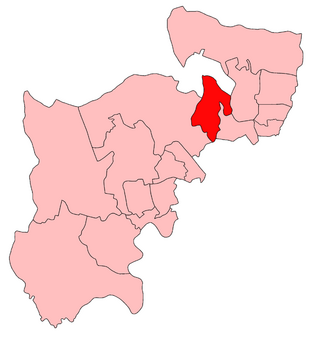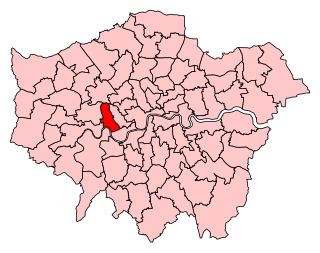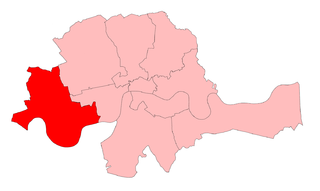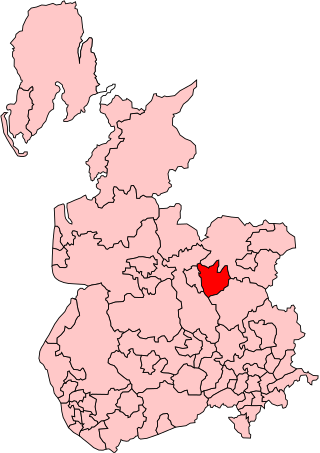
Finchley was a constituency represented in the House of Commons of the Parliament of the United Kingdom. It elected one Member of Parliament (MP) by first-past-the-post voting; its longest-serving and best-known MP was Margaret Thatcher, Prime Minister from 1979 to 1990. Although boundary changes meant that she never again attained the large majority by which she won in 1959, her constituents nonetheless returned her by comfortable (9,000) majorities at general elections throughout her premiership.

Hammersmith is a parliamentary constituency in the House of Commons of the UK Parliament. It is currently represented by Andy Slaughter, a member of the Labour Party, who has represented the seat since its recreation in 2010.

Chelsea was a borough constituency, represented in the House of Commons of the Parliament of the United Kingdom.

Accrington was a parliamentary constituency of the House of Commons of the Parliament of the United Kingdom from 1885 to 1983. It elected one Member of Parliament (MP) by the first-past-the-post system of election.
The parliamentary borough of Finsbury was a constituency of the House of Commons of the UK Parliament from 1832 to 1885, and from 1918 to 1950. The constituency was first created in 1832 as one of seven two-seat "metropolis" parliamentary boroughs other than the two which already existed: Westminster and the City of London; the latter until 1885 retained an exceptional four seats. Finsbury was directly north of the City of London and was smaller than the Finsbury division of the Ossulstone hundred but took in land of Holborn division to its southwest in pre-introduction changes by Boundary Commissioners. It included Finsbury, Holborn, Moorfields, Clerkenwell, Islington, Stoke Newington and historic St Pancras. The 1918 constituency corresponded to the smaller Metropolitan Borough of Finsbury ; it was a seat, thus electing a single member, fulfilling a longstanding aim of Chartism which underscored the 1832 reforms.

Hackney North was a parliamentary constituency in "The Metropolis". It returned one Member of Parliament (MP) to the House of Commons of the Parliament of the United Kingdom.
Hackney was a two-seat constituency in the House of Commons of the UK Parliament created under the Representation of the People Act, 1867 from the former northern parishes of the Tower Hamlets constituency and abolished under the Redistribution of Seats Act, 1885.

Clapham was a borough constituency in South London which returned one Member of Parliament (MP) to the House of Commons of the UK Parliament. It was created in time for the 1885 general election then altered in periodic national boundary reviews, principally in 1918, and abolished before the February 1974 general election. In its early years the seat was officially named Battersea and Clapham Parliamentary Borough: No. 2—The Clapham Division.
Stepney was a parliamentary constituency centred on the Stepney district of the East End of London. It returned one Member of Parliament (MP) to the House of Commons of the Parliament of the United Kingdom, elected by the first past the post system.

Whitechapel was a parliamentary constituency in the Whitechapel district of East London. In 1885 the seat was established as a division of the parliamentary borough of Tower Hamlets. It returned one Member of Parliament (MP) to the House of Commons of the Parliament of the United Kingdom.

Hornsey was a constituency that returned one Member of Parliament (MP) to the House of Commons of the UK Parliament, 1885 — 1983. It was then largely replaced by Hornsey & Wood Green. Its voters using the first-past-the-post system elected the Conservative Party candidate at each election. Its closest result was a 1.29% majority at the 1966 election which saw the start of the Second Wilson Ministry. From 1945 onwards the runners-up in the seat were the Labour Party candidates.

Hampstead was a borough constituency, centered on the Hampstead area of North London. It returned one Member of Parliament (MP) to the House of Commons of the Parliament of the United Kingdom, who was elected using the first-past-the-post voting system.

Brentford was a constituency named after the town of Brentford in Middlesex and was drawn to take in Hounslow, Norwood Green and Twickenham. It returned one Member of Parliament (MP) to the House of Commons of the UK Parliament. The constituency was created for the 1885 general election and abolished for that of 1918.

Kensington South was a parliamentary constituency centred on the Kensington district of west London. It returned one Member of Parliament (MP) to the House of Commons of the Parliament of the United Kingdom.

Limehouse was a borough constituency centred on the Limehouse district of the East End of London. It returned one Member of Parliament (MP) to the House of Commons of the Parliament of the United Kingdom.

Bow and Bromley was a constituency in the Parliament of the United Kingdom. Located in the Metropolitan Borough of Poplar in London, it was created by the Redistribution of Seats Act for the 1885 general election and returned one Member of Parliament (MP) until it was abolished for the 1950 general election.
Finsbury East was a parliamentary constituency centred on the Finsbury district of North London, England. It returned one Member of Parliament (MP) to the House of Commons of the Parliament of the United Kingdom, elected by the first past the post system.
Hoxton was a borough constituency centred on the Hoxton district of London. It returned one Member of Parliament (MP) to the House of Commons of the Parliament of the United Kingdom, elected by the first past the post system.
Haggerston, formally known as the "Haggerston Division of Shoreditch", was a borough constituency centred on the Haggerston district of the Metropolitan Borough of Shoreditch in London. It returned one Member of Parliament (MP) to the House of Commons of the Parliament of the United Kingdom, elected by the first past the post system.
St George was a parliamentary constituency in what is now the London Borough of Tower Hamlets. It was part of the Parliamentary borough of Tower Hamlets and returned one Member of Parliament (MP) to the House of Commons of the Parliament of the United Kingdom.


















